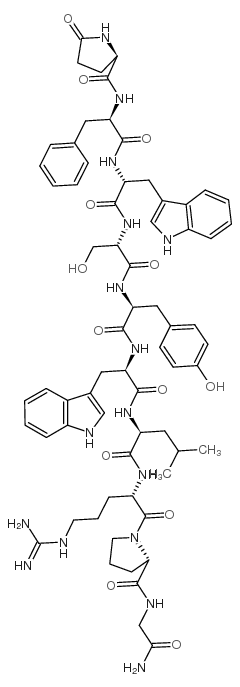Modulation of lordosis behavior of female rats by naloxone, beta-endorphin and its antiserum in the mesencephalic central gray: possible mediation via GnRH.
D J Sirinathsinghji
文献索引:Neuroendocrinology 39(3) , 222-30, (1984)
全文:HTML全文
摘要
The role of endogenous opiate peptides in the mesencephalic central gray (MCG) and their possible interactions with gonadotropin-releasing hormone (GnRH) in the regulation of lordosis behavior was assessed in ovariectomized, estrogen-treated and estrogen-progesterone-treated female rats. Lordosis behavior triggered by male mounting was enhanced by microinfusion of naloxone and anti-beta-endorphin-globulin (anti-beta-end-G) but not by anti-met-enkephalin-globulin or anti-dynorphin-globulin into the MCG in both estrogen-treated and estrogen- (low dose) progesterone-treated females. The potentiating effects of naloxone and anti-beta-end-G could be blocked by a preinfusion of either anti-GnRH-globulin or an antagonist analog of GnRH directly into the MCG. However, two potent antagonist analogs of GnRH were not effective in blocking lordosis indicating a dissociation between their neural actions and their known inhibitory effects on luteinizing hormone release. Conversely, beta-endorphin but not met-enkephalin or dynorphin infused into the MCG inhibited lordosis behavior in both estrogen-treated and estrogen-progesterone-treated rats. This beta-endorphin-induced inhibition of lordosis in the estrogen-treated rats could be overcome by GnRH microinfused directly into the MCG which potentiated lordosis to high levels. These observations provide evidence that beta-endorphin may be the sole opiate peptide in the MCG involved in the control of lordosis behavior and also suggests a functional relationship with GnRH systems in the MCG in such a regulatory mechanism.
相关化合物
| 结构式 | 名称/CAS号 | 分子式 | 全部文献 |
|---|---|---|---|
 |
(D-PYR1,D-PHE2,D-TRP3·6)-LHRH
CAS:68059-94-9 |
C67H84N16O13 |
|
Characterization of Leydig cell gonadotropin-releasing hormo...
1982-01-01 [Peptides 3(5) , 789-92, (1982)] |
|
Role of lipids in gonadotropin releasing hormone agonists an...
1982-03-15 [Biochem. Biophys. Res. Commun. 105(1) , 8-13, (1982)] |
|
LH-RH analogue acts as substance P antagonist by inhibiting ...
1985-07-01 [Brain Res. 337(2) , 357-61, (1985)] |
|
Indirect evidence for a physiological role exerted by a "tes...
1990-07-01 [Gen. Comp. Endocrinol. 79(1) , 147-53, (1990)] |
|
Jun localization in cytosolic and nuclear compartments in br...
2004-02-01 [Gen. Comp. Endocrinol. 135(3) , 310-23, (2004)] |